#lenticels
Text
Winter Trees and Shrubs: Sweetgum
Sweetgum is a distinctive tree at any time of year. It stands out among most other deciduous trees with its excurrent growth habit, which gives it a narrowly conical or pyramidal shape. Only in its advanced age does it begin to develop a more rounded and irregular form. Its leaves are star-shaped with either five or seven lobes and span between four and seven inches. Their glossy green color…
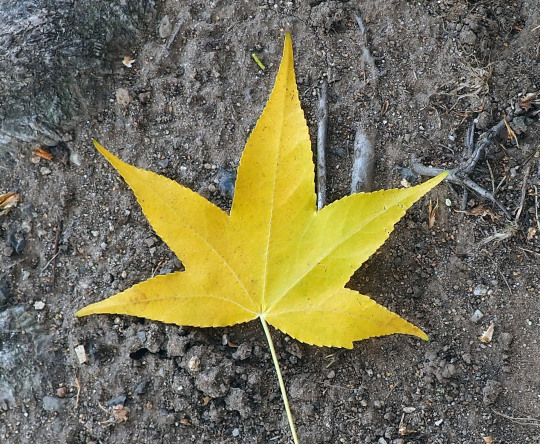
View On WordPress
#Altingiaceae#bark#branchlets#buds#Dispersal Stories#fall color#fruits#gumballs#leaves#lenticels#Liquidambar styraciflua#pith#plant anatomy#plant identification#plant taxonomy#resin#seasonal interest#sweetgum#winter buds#winter twigs
11 notes
·
View notes
Text
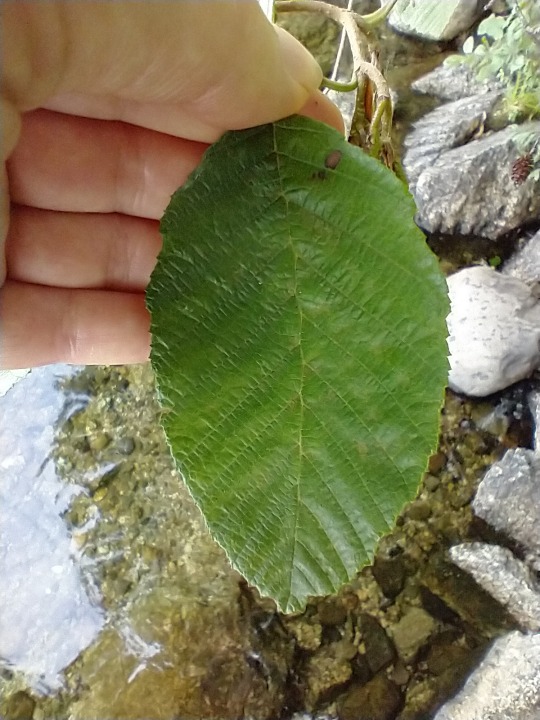

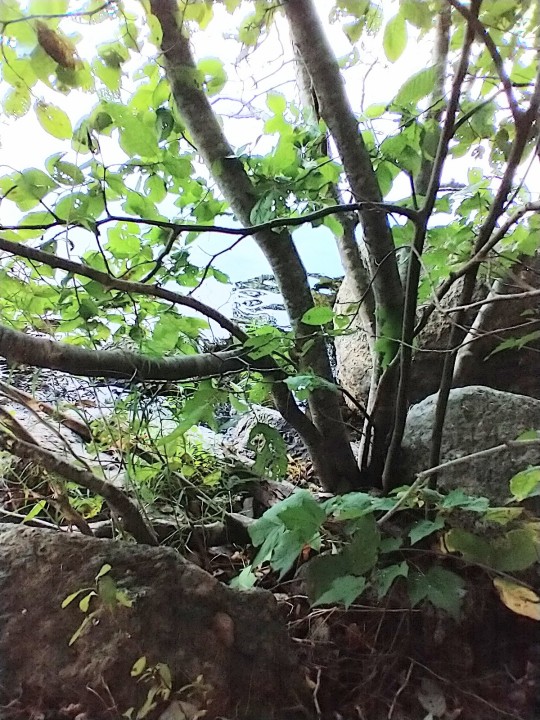

Hazel Alder
Location: Northeast shore of Phillips Lake, Dedham, Maine
Notes: this was a very difficult ID! This identification is based on leaf shape, cone shape, habitat, bark lenticels, leaf veins, and tree size.
Leaf shape was a rough match for several birch and many alder species. However, most had more serration or a different degree of roundness. The one characteristic these leaves had that stood out to me was that the major leaf veins did not visibly branch. They were very neat and well defined.
Hazel Alder is a perfect match for leaf shape, veining pattern, and degree of serration. The form of a woody shrub at the waters edge is consistent with hazel alder.
16 notes
·
View notes
Text
having an issue with my crop this year (NEED HELP)
these shits are mad fucked up, theres a brown staining of the vascular ring and a pale colored sticky ooze appearing at the eye lenticels
4 notes
·
View notes
Text
okay. I was right I was just spelling it wrong. Trees breathe through lenticels. Lenticles are a thing with rocks.
5 notes
·
View notes
Text
Dans mon biome
grâce à un léger et doux art glissant
j’accueille dans mon estran intérieur
ce balancement ligneux des mots sillons
qui s’amusent comme des lenticelles
et dans cette pneumatophore vitale
je sens battre mon cœur de Voh
enchanté par des crabes violonistes
aimantés par la lumière
car ce n’est pas ma faute
ce ne sont pas des marées cages
seulement les racines échasses
qui me maintiennent…

View On WordPress
4 notes
·
View notes
Text
Il frutto del pero è un FALSO FRUTTO chiamato POMO, infatti è dal ricettacolo che ha origine la polpa e non dall'ovario del fiore. Il vero frutto è il TORSOLO che contiene i semi. È generalmente tonda, ed il suo colore varia a seconda delle varietà, dal verde, al giallo o rosso con macchie, lenticelle e striature. La buccia è solitamente fine, liscia e resistente. Il picciolo, molto robusto, è fissato al frutto in una specie di incavo chiamato cavità peduncolare. All’altra estremità del frutto vi è un’altra cavità chiamata CALICINA. Quello che chiamiamo torsolo è in realtà il vero frutto: PERICARPO (formato da cinque camerette o logge). La polpa è bianca o giallognola, soda e succosa, di sapore dolce o acidulo, a volte farinosa.

9 notes
·
View notes
Text
What is the Significance of Transpiration in Plants?
Transpiration is the process by which plants absorb water through their roots and release water vapor into the atmosphere through small openings in their leaves called stomata. This essential function plays a crucial role in the plant’s overall health and survival.
In this article, we have looked at the complete process of Transpiration in plants, its classification, and its significance.
What is Transpiration in Plants?
Transpiration is the movement of water through a plant and its evaporation from aerial parts, primarily from leaves but also from stems and flowers. It helps in the regulation of temperature, nutrient uptake, and the transport of water and minerals within the plant.
This process is essential for plants to absorb nutrients and minerals from the soil. It also helps in regulating the temperature of the plant and maintaining its shape and structure.
Types of Transpiration
Three main types of transpiration occur in plants:
Stomatal Transpiration
Stomatal transpiration occurs through the stomata, which are tiny pores present on the surface of leaves. These pores open and close to regulate the exchange of gases and water vapor between the plant and the surrounding environment. Stomatal transpiration accounts for most water loss in plants.
Lenticular Transpiration
Lenticular transpiration refers to the loss of water vapor through specialized structures called lenticels. Lenticels are small, corky pores found on the stems and woody tissues of plants. They allow for gas exchange, including water vapor, to occur.
Cuticular Transpiration
Cuticular transpiration involves the diffusion of water vapor through the cuticle, which is a waxy, waterproof layer covering the outer surface of leaves and stems. While cuticular transpiration accounts for a smaller portion of total transpiration, it plays a crucial role in reducing water loss and protecting the plant from dehydration.
Important Factors Affecting Transpiration in Plants
Many factors affect the process of transpiration in plants, few of them are listed below,
Environmental Factors: Factors such as temperature, humidity, wind speed, and light intensity influence the rate of transpiration in plants.
Plant Factors: The size, age, species, and health of the plant affect its transpiration rate.
Soil Factors: Soil moisture content, nutrient levels, and root health impact the plant’s water uptake and transpiration.
Significance of Transpiration in Plants
Transpiration plays a vital role in the overall health and function of plants by:
Water Transport: Transpiration creates a negative pressure gradient in the xylem, facilitating the movement of water and dissolved nutrients from the roots to the shoots.
Cooling Mechanism: Transpiration helps regulate leaf temperature by dissipating heat through water evaporation, preventing overheating.
Nutrient Uptake: Transpiration aids in the uptake of essential nutrients from the soil by creating a transpiration stream, pulling water and nutrients into the roots.
Photosynthesis: Transpiration facilitates the exchange of carbon dioxide required for photosynthesis, enabling the synthesis of sugars and other organic compounds vital for plant growth.
Understanding the different types of transpiration and the factors affecting it is essential for optimizing plant growth and health. By recognizing the significance of transpiration, we can better appreciate the intricate mechanisms that plants have developed to survive in diverse environments. For personalised online tuition, Tutoroot offers the best option. Our biology tuition sessions can help clarify any doubts you have about these concepts. Click here to book a FREE DEMO session.
0 notes
Text
Here we have Oemleria cerasiformis, in the ROSACEAE family! It has several common names, including osoberry, Indian plum, and June plum.
This deciduous shrub can be identified by its smooth edged, narrowly oblong alternating leaves, which have the scent of bitter cucumber. Its flowers are greenish white in pendulous clusters. The fruit is a thin fleshed drupe that is purple-black when ripe.
Oemleria cerasiformis' native range is from British Columbia to California. It possesses lenticels in its stems that provide oxygen access in low oxygen soils, and is able to reproduce vegetatively through root suckering. It attracts pollinators as one of the earliest bloomers in the spring. As like other members of the rose family, its seeds contain toxic compounds as an herbivory defense.




0 notes
Text
Flora Meets Fauna
We grew up in a house at the top of a hill,
With a yard that stretched on, long and wide.
Divided in thirds by graying wood fences
and the metal arched trellis built for sweet morning glory to climb.
Speckled by fruit trees,
Overgrown with juniper and rubber rabbitbrush.
I can still feel the soft puncture of powder blue juniper berries
and the crush of their cones hidden inside.
I have vivid half-memories of that skinny mottled trunk,
Dark amber bark glowing red in the setting sun.
A decade and a half after the tree died of natural causes,
My mother says she never got to taste its cherries.
It was only us:
Myself, my sisters, who climbed up to nestle in its branches
And feast upon the fruit hidden within.
It was only us, and squadrons of orderly red ants scavenging low hanging fruit
and the birds who picked at the crown only they could reach.
Only us, climbing up into her trembling limbs,
Bark stretched and split like old scars.
We picked and ate anything left, brushing leaves out of our faces
And spitting the pits onto the ground below.
I can’t remember how they tasted,
But their absence sits like a stone in my heart.
All the trees shed their leaves and went dormant every winter,
It was clockwork, we knew just how to
Rake the leaves into a pile, bag them up before they rot beneath the snow.
When we didn’t, we would learn just how much harder the ground could grow
And what it meant to starve the perennials.
The trees went dormant every winter and we waited for the warmth,
And we waited for the cherries,
But then came spring, summer, and autumn—
Our peach tree was a thing of beauty:
It grew sidling on top of the hill, nestling against lilacs.
The trunk was broad and divided low into strong, heavy branches.
Wrapped in elder gray-brown lenticels, growing lighter in color
As it reached for the sky.
Its youngest branches shone bright green, fading to red—
budding fragrant, verdant, oblong leaves.
Every other year it bore a bounty of gorgeous
Golden fruit, exquisitely sweet.
The pink and yellow flesh was soft and sun-warmed,
And the juice streamed all the way down to my forearms,
After just the first bite. Yielding against my front teeth.
I can still feel the bristly peach fuzz
Which coated my arms as we picked
Plastic laundry pails full of fruit to feed the whole family.
My parents did all in their power to keep this tree alive,
Wrapping her sagging old branches together, dressing her wounds,
Building a support structure to hold her up.
But God knows how long she served that house—
Or whose original hand lovingly raised her from the ground—
But our tree was doomed from the start.
For her greatest branch extended beyond our yard.
For a decade or so, the exchange worked:
He could take all of the peaches that grew on his side,
A bounty and blessing we nourished.
And for ages I couldn’t imagine what could compel him
To saw that gorgeous branch off and discard it,
Leaving our beautiful tree bereft, bleeding honey-colored sap.
But it’s a simple, philistine answer: he didn’t like children,
Or seeing our overgrown back garden beside his perfectly mowed lawn.
He built a ten foot fence,
And the peach tree died that same summer.
Another decade passed and
Her skeleton still stands there, brittle branches reaching up
Like twisted aching fists into the sky.
The birds still perch upon its ghost, and mom hangs feeders
With seeds and homemade nectar from her stable center.
-Lane Aconite,
Original draft written April 25th, 2023
Edited March 14th 2024
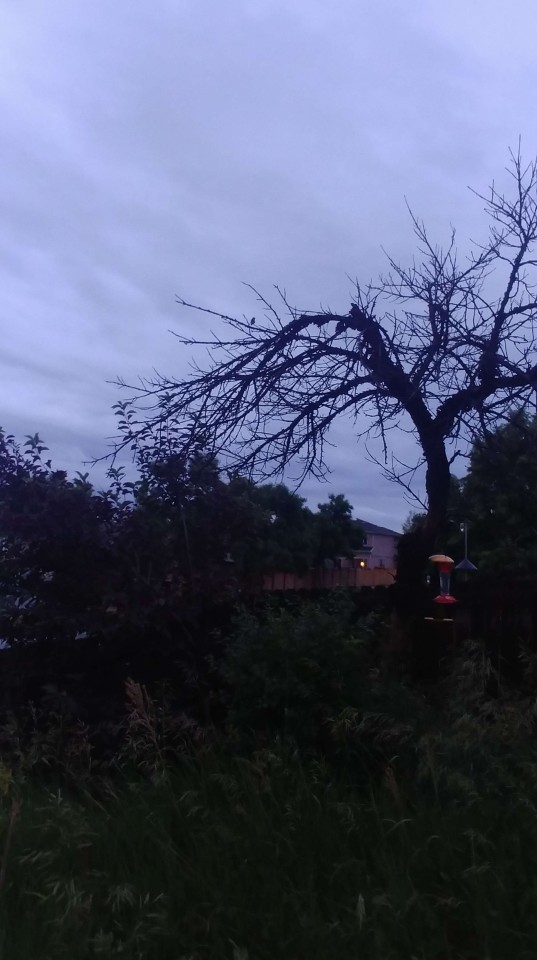
Hello my lovely readers, this is another poem of mine that's been edited so significantly from its original that I wanted to include my first draft below the cut.
The story the poem above tells is a more grounded and nuanced emotionally, as well as more vivid in its imagery. It captures the scope of the story in a more honest way than my first version, which was too soaked in the acerbity I was feeling at the time. I just didn't have the energy to give it my all like I do now.
We grew up in a house at the top of a hill,
The yard was speckled by fruit trees.
After the tree died of natural causes
My mother says
She never got to taste its cherries.
It was only us:
Myself, my sisters, and squadrons of orderly red ants
Who climbed the trunk and feasted on the low hanging fruits
And the birds who picked at the crown only they could reach.
Only us, climbing up into the trembling
Grey-brown branches.
We picked and ate anything left,
Spitting the pits onto the ground below.
I don’t remember how they tasted,
But I remember their absence keenly.
The peach tree was a thing of beauty
The trunk broad, thick, and divided
Low into strong, heavy branches,
With fragrant, verdant, oblong leaves.
Every other year it bore a bounty of gorgeous
Golden fruit, exquisitely sweet.
The yellow and pink flesh was soft and sun-warmed,
And the juice streamed all the way
Down to my forearms,
After just the first bite.
I can still feel the bristly peach fuzz
Which coated my arms as we picked
Laundry pails full of fruit.
My parents did all in their power
To keep this tree alive
But it was old, and doomed,
For a great branch extended beyond our yard.
And for a time, the exchange worked:
He could take all of the peaches
That grew on his side,
A bounty and blessing we nourished.
I can’t imagine what compelled him
To saw that great branch off,
Leaving our beautiful tree bereft,
Bleeding honey-colored sap.
The peach tree died that same summer.
The truth of the matter is yes, both trees died. I can't eat peaches from the grocery store because they're picked early in the season to be shipped across the country and ripened artificially using ethylene gas. This method only penetrates the outer layer of the fruit, so they look pretty but appearances can't hide how hard and sour their flesh becomes the closer you bite toward the pit. Artificially ripened fruits can also be toxic to workers producing them and the consumer depending on the chemicals used. The summer sun's just irreplaceable.
The cherry tree was chopped down, the trunk left partially standing in a shape somewhat like a seat. I used to sit there sometimes to write in my journal. A surprise peach tree sprouted up in the middle of my parents' greenhouse from a spat peach pit, or one that rolled down the hill while picking. They had to move the greenhouse to the opposite side of the hill, digging out a huge recess to fit it, just so this new tree would thrive and bear fruit. I helped in moving the greenhouse, but moved away that autumn. The new peach tree bore her first fruit that year, and even more the next, but I still haven't had a chance to visit and taste a real peach again.
#poetry#my work#lane archives#lane speaks#i went on a lil research hole about artificial ripening of fruits on a few academic databases a couple months ago#for a lil bit it's genuinely shocking how little regulation there is across the world on what chemicals can be used & how till you remember#oh yeah historically agricultural workers have been some of the most exploited groups & of course it hasn't changed#in fact with the global supply chain it's really ramped up#like food ripened with regular ethylene gas is “generally considered safe” by the FDA#but it's more expensive than ethylene oxide. longterm exposure to which is actually toxic#& then there's acetylene gas from calcium carbide which can cause intestinal damage overtime & more cause of traces of arsenic/lead/phospho#-us#etc. The main victims of these chemicals being the agricultural workers who are interacting with them regularly#Suffering exploitation & chronic disease & shortening their lives just so year round we can eat fruit that doesn't even taste good#So many folks have forgotten or maybe haven't ever known what a sun-warmed fruit feels like on your tongue but it's heaven#The carnage isn't worth it#We need local sustainable agricultural practices even if it means sacrificing the foods that we love
1 note
·
View note
Text
Download all ‘Sir Billy songs’ Mp3 Download
Download Sir Billy’s songs Album: The top-trending Nigerian gospel singer and Minister, Sir Billy drops new miraculous studio songs and called them, “Watarana” ft Lenticel, “Sold Out” ft WMI Mass Choir, “Yesu Kadai”, “Jagorana” Ft Levi, ” Karba Reloaded” ft Karba Awardees & Jakes Hinjari. The spirit-filled studio project that will bless and inspire a lot of people, comes fully prepared with Six…

View On WordPress
0 notes
Text
Mangrove restoration and reforestation: the whys and the hows
Amidst the myriad of unique plant assemblages found around the world, perhaps none are as tenacious and resilient as mangroves. Mangrove is an umbrella term that groups all tree and shrub species depicting physiological adaptations to high salinity conditions and inhabiting tropical and sub-tropical inter-tidal zones. Mangrove restoration is currently gaining a lot of interest globally.

‘Adapt to salt water my friend’
Mangrove species, however, have developed several morphological adaptations to not only survive but thrive under these conditions 1. They have stilt roots akin to a banyan tree that not only extend support against the tidal forces but also act as extended breathing appendages during high and low tides. These roots have specifically adapted cellular pores called lenticels that allow for the ready diffusion of oxygen into the plant while also being hydrophobic, preventing salt water from entering the cells and dehydrating the tissues.
Apart from stilting, some roots also prop up from the ground like arrows and perform both photosynthesis as well as respiration as required by the plant and are called pneumatophores. Astonishingly, several mangrove species depict the animal-like trait called vivipary! This is the phenomenon in which the offspring begins development while still attached to the parent plant (as in humans). Besides this, they have several other adaptations including leaf succulence and ultrafiltration mechanisms to ensure the salt is selectively filtered out.
Genetics reveal that these fitness traits have independently arisen across fern, monocotyledons, and dicotyledons from initially non-mangrove species (convergent evolution). Only around 70 species of true mangroves, i.e. species that grow only in mangrove environments and do not extend into terrestrial plant communities, are found across the world.
But why do we need mangrove restoration?
They are your coast guards
As remarkable as these adaptations are, they aren’t the only characteristics that make mangrove forests special. Mangroves act as sentinels of our coastline by providing a buffer from tropical storms, cyclones and tsunamis. The roots slow the flow of water helping reduce soil erosion while their prop roots (stilts) act as filtration meshes for inorganic pollutants and harmful metals brought by rivers and streams and therefore let out clean water into the oceans.
They are your climate warriors
Mangroves are not only buffers against natural calamities but also of tremendous importance for mitigation and adaptation strategies in response to climate change. Globally, they have been modelled to sequester 21 gigatonnes of carbon which is remarkable considering they only comprise 0.1% of the terrestrial land cover 2! This is because of their numerous niche physiological traits such as the proliferation of succulent foliage and root systems mentioned above. This means that on average, mangroves are ten times more productive as carbon sinks than terrestrial forests.
What corals are to marine ecosystems, mangroves are to terrestrial ecosystems ?
The nutrient-rich sedimentary beds near the mangrove roots act as a micro-habitat for a blistering number of micro-invertebrates and aquatic flora such as fishes, crabs, sea snails, shellfish, and algae. These in turn through the food web support a vast array of wildlife and other associated plant species. Leaf falls from mangrove species help in nutrient provisioning for other mangroves as well as coral reefs.
Several molluscs and crustaceans including sessile barnacles and mussels find refuge amongst the mangrove prop roots from rapid tidal waves. The soft mud banks in mangrove ecosystems also provided burrowing habitats for mudskippers and crabs and nesting habitats for sea turtles. Numerous lizard species and saltwater crocodiles also prefer the mangrove habitat as it offers them plenty of predation opportunities. Mangroves also provided nesting grounds for thousands of migratory birds from across the globe.
Estimates suggest that mangroves are refuges of 341 threatened species across the world! The Sundarbans, the largest contiguous stretch of mangroves in the world spread between India and Bangladesh, alone are home to over 42 mammal species, 35 species of reptiles, 300 species of birds, 250 species of fish, and over 350 species of vascular plants besides innumerous phytoplankton, fungi, bacteria, zooplankton, benthic invertebrates, molluscs, and amphibians.
Human livelihoods are inextricably linked to mangroves
Mangroves also support human societies, for example, Sunderbans is one the most population-dense regions in the world. These forests are named so because of the dominance of a mangrove species called the Sundari tree ( Hereteria formes).Communities here are dependent on several species for charcoal, fuelwood, fodder, thatch for home-building, wildlife, fish, medicines, tannins and many more products. For example, Sonneratia alba also called mangrove apple and Nypa fruticans are widely harvested mangrove species.
Mangrove honey collected by the Moulis in the Sunderbans, also called blood honey because of the number of lives lost to man-eating tigers during collection, holds a plethora of medicinal advantages over regular honey 3. Several forest-dwelling communities such as the Australian Aborigines eat the fruit of mangrove trees after removing harmful tannins from the fruits by soaking them in mangrove mud for three to seven days. In Tamil Nadu in India, the chemical extracts of a mangrove species called the Thillai tree ( Excoecaria agallocha) are believed to treat leprosy!
As with many other ecosystems, mangroves are under severe pressures
Despite such a vast array of ecosystem services provisioned by mangroves, they are amongst the most threatened ecosystems. At the turn of the millennium it was discerned that global mangrove cover had shrunk by half compared to its pre-industrial range and the remaining showed alarming signs of degradation.
The reasons for mangrove loss are multifarious but can be broadly attributed to shrimp farming which requires the conversion of mangrove swamps to embanked ponds; sea level and temperature rise driven by climate change resulting in their habitat shrinkage as year-by-year lowland coastal areas are submerged; conversion of forests to agricultural land especially for paddy cultivation; coastal development for ports and tourism; and over-harvesting of forest produce such as fuelwood, fodder and fruiting species.
But what is the process of Mangrove Restoration?
In lieu of severe threats to mangroves amidst the pivotal role they play in sustaining biodiversity, natural resources and human livelihoods, great emphasis has been put on mangrove reforestation. Large tracts of land are being managed for mangrove plantation and assisted natural regeneration. These include the direct plantation of mangrove species and/or improving eco-hydrological conditions in estuarine zones that supplement mangrove regrowth.
Plantation drives consist of raising suitable species in nurseries from seedling to sapling stage followed by replantation on suitable mud banks. Seedlings are collected naturally i.e. seedlings dispersed by sea water instead of directly being harvested from trees using the mangroves’ natural seedling germination characteristics (vivipary). Species selection is of particular significance as successful survival rates are determined by choosing species keeping in mind their salinity requirements, days of inundation, and natural habitat zonation.
Species matter a lot in Mangrove Restoration
Mangrove species depict characteristic zonation (species adapted to lowland, midland or upland areas) and have differential thresholds for salinity. Plantation drives must only use the species native to nearby ecosystems and references are usually drawn from nearby tracts of natural undisturbed mangrove forms. Plantations must also consider the days in a month the area experiences inundation by seawater.
These are determined by the level of seawater during spring and neap tides, with usually lowland areas during neap tides considered as the lowest topographic threshold for plantation. The most successful restoration case studies attempt to emulate natural ecosystems. Furthermore, the restoration area must be surveyed beforehand for disturbances both natural (invasive species, erosion, embankment damage by cyclones) and anthropogenic (vicinity to grazing, agriculture and shrimp farms) and the local communities must be involved in their protection and management activities through educational outreach ensuring benefits are shared with the concerned stakeholders.
Besides nursery plantations, sometimes mangrove reforestation also includes direct seedling plantation when adequate skilled labour and/or infrastructure restraints don’t permit nurseries. In the state of Gujarat on the Western coastline of India, the topography along the coasts doesn’t depict a gradual slope but rather abrupt rocky undulations that give way to strong intertidal currents which damage seedlings and saplings. In such cases a local technique called the Otla raised bed method is used in which saplings are planted on earthen mounts raised to 10–15 cm in an alternating triangular pattern to reduce to ebb and flow of currents 4.
The Role of Hydrological Conditions in Mangrove Restoration
Hydrological conditions play a tremendous role in mangrove growth and coupled with the incredible resilience displayed by mangrove species, more attention is being drawn to reestablishing the eco-hydrological conditions supporting mangrove species rather than direct plantations. This is called assisted natural regeneration wherein the focus of restoration is on establishing environmental conditions conducive to natural regrowth rather than plantations.
It has been widely observed that provided the hydrological conditions are appropriate (frequency, duration and level of inundation by sea water) and disturbances are kept to a minimum, mangroves show a remarkable ability to regenerate by themselves without requiring plantation! The most successful mangrove reforestation efforts put a greater emphasis on the latter, improving conditions of sustained inundation on gradually sloping mud banks in coastal backwaters to support natural regeneration rather than direct interventions through plantations. This allows mangroves to develop their natural species composition which is often more diverse than plantations of 2–3 successful species, resulting in a wider array of ecosystem services and species richness.
What about the fishbone channel?
The fishbone channel intervention utilised by the forest departments along the Kaveri and Godavari estuaries in southern India is a prime example of assisting natural regeneration 5. The mangroves here were hampered in their regeneration because of poor inundation (some areas were over-inundated during high tide and others were cordoned off from inundation due to local geology). Channels were dug akin to a boney fish’s skeleton to ensure that seawater gradually inundated these mangrove sites leading to vastly improved restoration results.
Such instances of naturally assisted regeneration are favoured as they offer sustainability in the long run. These mangrove congregations upon establishment tend to be far more resilient to disturbances than artificially planted forests. Many reports cite a complete recovery in 3–5 years if restoration sites are monitored and protected well. These insights shed light on how nature can recover quickly on its own without too much human intervention if sound ecological principles are applied rather than forcing human-engineered mono-plantations in desperation for quick results.
We at Think Wildlife Foundation recently launched our Livelihoods for Conservation project to provide alternative, sustainable livelihoods to the communities living with wildlife. This is with the aim to incentivize conservation while uplifting these communities economically. You can purchase merchandise from these communities here!
Written by: Rishabh Srikar
Originally published at https://thinkwildlifefoundation.com on June 3, 2023.
0 notes
Text
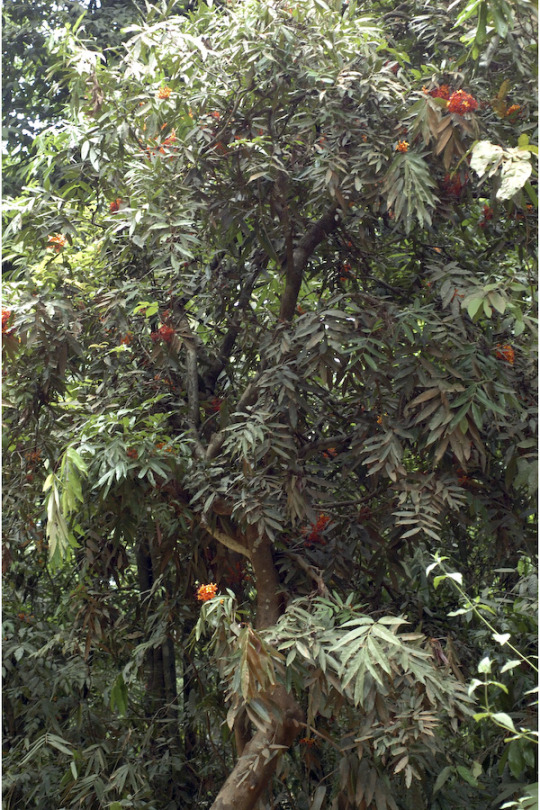



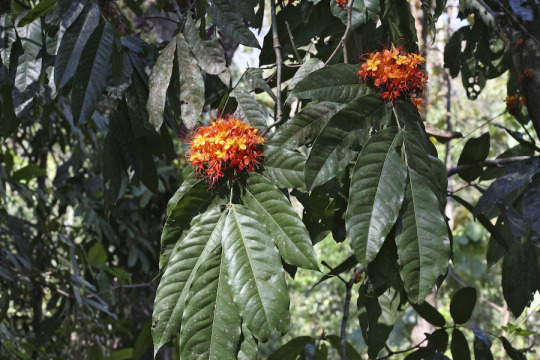
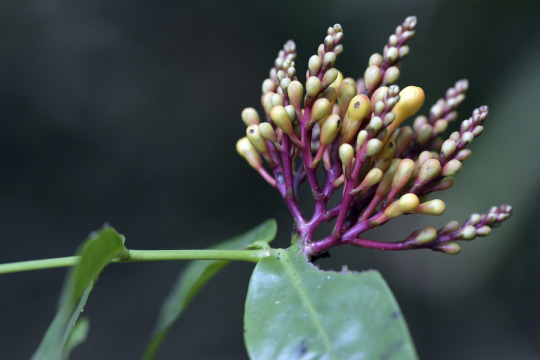
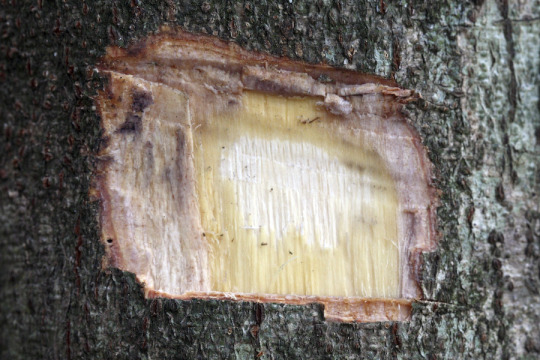



Saraca Asoca - Asogam
Saraca asoca (Rexb) de wilde
வேறு பெயர்:-
அசோகம்
ஆயில்
செயலை
பிண்டி
காகோளி
மேற்குமலைத் தொடர்ச்சியிலும் விசாகப்பட்டணம் முதலிய இடங்களிலும் பயிராகிறது. மற்ற தோட்டங்களில் வைத்துப்பயிரிடப்படுகின்றது.
இதன் பூ ஒரு பூங்கொத்துப் போன்று இருப்பதுடன் மனத்தைக் கவரும்படி பட்டுப்பூச்சி நிறமொத்த செம்மை நிறமுள்ளதாயிருக்கும். இது மாசி, பங்குனி மாதங்களில் பூக்கும்.
ப-உ: பூ. பட்டை
சுவை: துவர்ப்பு
தன்மை : தட்பம்
பிரிவு : கார்ப்பு
செய்கை : துவர்ப்பி, குலக வெப்பகற்றி, சூலக உரமாக்கி(Astringent, Uterine Sedative, Uterine Tonic)
குணம் : சூலக அழற்சி, சூலசுத்திலிருந்துண்டாகும் குருதிப்பெருக்கு (பெரும்பாடு ). குருதியழல் நோய், குருதிபேதி. தீப்பிணிகள், நீரிழிவு ஆகிய இவைகள் நீங்கும்.
*****
வாதபித்த சேத்ம வரிசைபெறு மூவருக்கும் ஆதரவாய் மெய்யி லமருமே-பூதலத்தில் வீண்பிண்டி போல விடுமுடம்பை யுந்தணிக்கும் காண்பிண்டி யாமசேசும்.
முக்குற்ற உடலினர்க்கும் நன்மை புரிந்து, மாவைப்போல் உளுத்த உடம்பை இறுக்கி, வன்மையைத் தருவது அசோகாகும்.
(தே-வெண்பா)
*******
குறிப்பு : உதிரவேங்கை, ஒடுவடக்கி, விடத்தலை, விளா, வேல் இவைகளின் குணம் ஆசோகுக்குமுண்டு.
பூவின் பயன் : பூவை நுண்ணியதாய்ப் பொடித்து. கால்பலமெடுத்து ஆழாக்கு நீருடன் கலந்து கெ டுக்க, குருதிக் கழிச்சலும் குருதியும் சீழுங்கலந்த கழிச்சலும் நிற்கும்.
பட்டையின் பயன் : பட்டையையிடித்துச் சாறுபிழிந்து கால் முதல் ஒரு உச்சிக்கரண்டியளவு (1/4-1 uchikarandi) கொடுத்துவர, பெரும்பாடு தணியும்.
பட்டை 105 கிராம் எடுத்துச் சிதைத்து, இரண்டு ஆழாக்கு பசுவின் பாலும் எட்டு ஆழாக்கு நீரும் கலந்து, ஐந்தில் ஒரு கூறாகச் சுருக்கி நாள் ஒன்றுக்கு இரண்டு மூன்று முறை கொடுத்துவர பெரும்பாடுமுதலிய குருதிப் பெருக்கு நிற்கும். கருப்பைக் குற்றம், வீட்டுக்கு விலக்கான மூன்றாம் நாளுக்குமேல் தொடங்கிய குருதி நிற்கும். கருப்பைக் குற்றம் நீங்கிப் பலப்படும்.
_-------------_---------------_-------------_------------
GEOLOGICAL DISTRIBUTION
Mainly in Asia and
some parts of North America. The tree is found mainly
throughout India, especially in West Bengal, Assam,
Odisha, Tamil Nadu, Karnataka, Kerala, Andhra Pradesh,
Meghalaya and Maharashtra.It is also widely distributed across the Western Ghats (both South and Central), the
Sahyadri region and throughout the Himalayas. S. asoca
is also found in countries such as Pakistan, Sri Lanka,
Bangladesh as well as Burma and in Malay where it
grows at an altitude of ~750 m. Saraca declinata also known as Red Saraca is present in Florida
(USA), Burma and Sri Lanka.
HABITAT
Trees, to 10 m high, bark 2-3 mm thick, surface brown or brownish-black, lenticellate. Leaves paripinnate, alternate; leaflets 6-12, opposite, 7-28.5 x 2-8.5 cm, narrowly oblong, oblong-ovate or ovate-lanceolate, round, cuneate or acute, apex acute or acuminate, base obtuse, margin entire, glabrous, coriaceous; stipules 7-20 mm long, intra petiolar, scarious, ovate, connate; rachis 4-25 cm long, slender, pulvinate, glabrous; petiolule 2-10 mm long, stout, glabrous; lateral nerves 10-15 pairs, pinnate, arched towards the margin, slender, faint, intercostae reticulate, faint. Flowers bisexual, yellow-orange or red, in dense sessile paniculate corymbs, axillary to leaves or leaf scars; bracts ovate, small deciduous; bracteoles 4 mm long oblong-spathulate, ciliolate, coloured, subpersistent. Calyx 4 cm long, petalloid, cylindric, enclosing a lobed disc; lobes 4, ovate-oblong, unequal, spreading, imbricate. Petals 0. Stamens 7 or 8, much exserted, free; filaments long, filiform, coloured, glabrous; anthers versatile. Ovary half inferior, stipitate, the stipe adnate below to one side of the disc, pubescent; style incurved, glabrous, filiform; stigma small, capitate; ovules many. Fruit a pod 10-5 x 2-5 cm, flat, oblong, coriaceous or almost woody, tapering at both ends; continuous within; seeds 2-8, 3.8 cm long, ovoid, slightly compressed. IUCN LIST - VULNERABLE
FLOWERING - FEBRUARY TO AUGUST
1 note
·
View note
Text
LA PERA KAISER
Si riconosce facilmente la buccia di un bel color ruggine, ricoperta di lenticelle. La polpa è giallina e leggermente granulosa, di sapore aromatico e dolce acidulo, consistenza dosa e croccante e quindi molto adatta a sopportare la cottura. SE non trovate le kaiser, vanno bene anche le abate feitel, molto diffuse. L’importante è che scegliete frutti appena morbidi al tatto, non troppo maturi,…
View On WordPress
0 notes
Text
DOTK
devotion by Kesha Trippett
Peeling the layers.
While prepping my ingredients for the dinner I was making, God spoke to me, and I felt like I should share.
I was peeling potatoes for a chicken pot pie, and a couple of the taters were getting ready to go. They were covered in “eyes” or buds and had developed some bad spots that looked like rot. As I peeled away the skin with my peeler, I thought how odd it was that the outside could look completely spoiled while the inside was still good. Layer by layer, the bad stuff was removed and what was underneath looked like a brand-new potato.
I looked up some of the things that grow on the outside of a potato, and one of the answers I got was this. “The white bumps are actually called lenticels. Lenticels are special pores in the plant tissue that allow oxygen exchange with the outside world, allowing the potatoes to “breathe.”
Then God reminded me that we are like this. Sometimes we can feel spoiled. Sometimes we look at the outside circumstances and forget what is on the inside. Sometimes it’s our exterior environment making us go bad. But we are not bad on the inside. We weren’t ever created that way. The fungus in our lives will develop and continue to grow if we don’t recognize it and make a change. And even though you can peel away all of that ickiness to find a new clean, and well inside, it doesn’t mean that the peeling didn’t hurt or cause pain… a peeler is a sharp razor-like blade that will tare away the outside layers exposing what is underneath, but it’s necessary to clean away that in which is threatening its entirety. Some spots are easily removed, while other times, you have to dig deep into them, leaving a gash or changing the shape. If God is the farmer and sin is the rot, then the Holy Spirit is our peeler.
This was a huge takeaway for my heart, and it happened all while standing at the kitchen sink.
2 Corinthians 5:17 says, “Therefore, if anyone is in Christ, the new creation has come: The old has gone, the new is here!”
Prayer: Thank you, Father, for speaking directly to my heart. Make me a new creation and purify my heart, oh Lord. Help me to spread your good news and wisdom and remove all the toxic spots in my life. In Jesus’ name, Amen.
By Kristen Mattus, DOTK Community Writer
0 notes
Text
Contact Lens Intolerance And Smile Eye Surgery by Dr. Rajiv Bajaj
Overview
About 40 million Americans depend upon contact lenses for temporary solutions to vision problems. Contact lens intolerance (CLI) is a term that indicates the stage at which the eye cannot tolerate the lens that we have been using for years. The eyes treat the contact lenses as foreign particles, and inflammation begins to occur in the eyes, and there may also be signs of rejection of the lens. If the person suffering from this condition uses any contact lenses, he/she may not be able to use them for a long time. If the lenses are used for a long time in such conditions, then the wearer may experience discomfort, pain, and in some cases, injury also. Most contact lens users who use it to correct the different forms of refractive disorders might have experienced one or the other form of contact lens intolerance. It is a common eye condition and the chances of getting affected by its increase with age.
What Are The Symptoms Of Contact Lens Intolerance?
Some people experience the symptoms once or twice a year, while others may feel it daily. It means that they would not be able to wear the contact lenses anymore. Some of the symptoms of the contact lens intolerance are given below:-
Redness.
Irritation.
Inflammation.
Dryness and itching.
Feeling of stinging pain at the time of applying contact lens.
Development of ulcers in the cornea (the clear outer layer at the front of the eyes)
Abrasion in the cornea
Risk Factors Associated With Contact Lenses.
Some of the risks with the use of contact lenses are:-
About 30 to 40 Percent of people who use contact lenses do not follow the care instructions required to use the contact lenses. Due to this, the lenses may irritate the eyes after some use.
Improper cleaning techniques and replacing contact lenses more often can also lead to a serious eye infection.
What Are The Solutions To Contact Lens Intolerance?
Several ways can be used to get rid of these contact lens intolerance and symptoms of Contact lens intolerance.
Eliminating the symptoms and signs of contact lens intolerance is also important because of the pain and discomfort caused by it.
If you face any signs and symptoms of contact lens intolerance, you should visit the doctor. He/she will first try to correct it by changing the brand and quality of the lens. If it is still not treated, the doctor may advise some surgical methods to treat the condition.
The best way to terminate the problem of contact lens intolerance is to undergo laser vision correction surgery called SMILE eye surgery.
Small Incision Lenticellate Extraction (SMILE) is a minimally invasive surgery known as keyhole surgery. It is done by using a VisuMax femtosecond laser.
It is a bladeless and flapless surgery. However, it is less invasive than any other laser vision correction option.
Since the incision made is so small and no flap is created in this surgery, the chances of flap complications are also reduced to a greater extent.
The recovery time is the least in this procedure. Also, theduration of this surgery is very short. Small Incision Lenticellate Extraction (SMILE) eye surgery is used to correct the different refractive errors of the eyes like near-sightedness (a person can see near objects but may find it difficult to focus on far placed objects), far-sightedness (the person can see the far object but near objectsmay seem to be blurry), and astigmatism (in this condition the shape of the cornea of the person is changed).
Therefore, reducing the requirement of any eyeglasses or contact lenses. In addition, this surgery method is suitable for people who are not a good candidate for other laser eye surgery like LASIK or PRP surgery.
Conclusion
Contact lens intolerance is caused by several factors like carelessness in using contact lenses and not following the safety and care instructions about the use of contact lens use. It can cause day-to-day variations in the person’s daily life. Usually, after long term use of the contact lens, this condition may occur. In this condition, the eye starts showing the signs of rejection of contact lenses and may cause pain and discomfort. Numerous methods can be used to prevent it. SMILE surgery is a good method to cure contact lens intolerance.
Tags: Smile eye surgery in delhi , LASIK Eye Surgeon In Delhi, LASIK Eye Surgery Center In Delhi
0 notes
Text
Best Enterprise Risk Management Certification in India - Netrika Consulting

Overview of Risk Management Courses, India
A certified risk management professional is actively engaged in the strategic planning, project management, auditing, control, and consultancy of the business. It is this nature of the profile that requires a certified risk manager to be adept in the business technical know-how and inclined towards garnering every possible information for identifying and averting potential risks to the organization.
Aspirants planning to advance their career to become certified risk management professionals must be aware of the actuarial practices in business alongside the eligibility criteria required to make the transition. We have curated a brief yet vital lenticel to facilitate your career choice of a certified risk professional.
The road to becoming a certified risk management professional commences with getting an insight into the course details. Understanding the course details enables the aspirant to create a streamlined strategy which further helps in passing the course successfully.
The certified risk management professional course encapsulates four prime domains:
Enterprise risk management overview
Management, Culture, and Control under enterprise risk management
Tools and Techniques for certified risk management professional
Types of risks in a business
Core competencies of a certified risk management professional
While on the trail of enhancing one’s professional value through a certified risk management professional course, it is vital to access one’s competencies. This provides an enhanced acceleration to your dream career choice. The core competencies considered an advantage for an aspiring certified risk management professional are:
A knack for analysing business models
Capable of designing and implementing organizational risk strategies
Developing risk competency in business and supporting decision making
What is the eligibility to apply for a certified risk management professional course?
Bachelor’s degree or equivalent
A minimum of one year of experience in industrial verticals relevant to risk management, corporate governance, audits, project control.
For non-degree holders, a minimum of seven years of risk management experience is mandatory
The risk management certification online and offline benefits varied profiles in an organization viz. risk management and corporate governance specialists, project managers, internal or external auditors, compliance officers, business consultants, etc.
To ease the process of gaining a certified risk management professional designation and assist in the career-defining journey, Netrika provides the Certified Risk Management Professional course. Our accredited certification validates the risk professional’s performance ability, technical knowledge to enhance their career growth and contribute to detecting and deterring enterprise-wide risks.
After preparing for the exam, you have to understand the exam blueprint, mock tests, and take the exam!
Take the exam and pass. After you pass the exam, you will receive a certificate suitable for display and your RIMS-CRMP lapel pin. Your RIMS-CRMP Certification is valid for two years.
Re-certification, or continuing education for your risk professional career!
Recertification is what distinguishes professional certification from other types of learning and development activities. Industries, laws, and other requirements are constantly changing, and professionals who pursue continuing education regularly are more informed and up to date with what is happening within their profession.
The recertification period begins on the certification date and ends two years on the first day of the month following the date of certification. Any subsequent recertification periods will run from the final day of the recertification month through the first day of the subsequent month after two years. RIMS-CRMP holders may submit the RIMS-CRMP Application for Recertification at any time during their two-year recertification cycle if they have attained the required 50 points.
Risk management certifications help professionals learn the organisational skills to assess and prioritise real and potential risks, and they often use matrices in the risk assessment process.
Original source - https://training.netrika.com/blogs/certificate-in-enterprise-risk-management/
#Risk management certification#Risk management courses#Risk Management Certification Online#Risk Management Professional#Risk Certification#Risk Management Courses Online#Certificate In Enterprise Risk Management#Certified Risk Manager (CRM)#Enterprise Risk Management Certification#Risk Management Courses India#Financial Risk Management Certification#Financial Risk Manager Certification#financial risk management course in india
0 notes